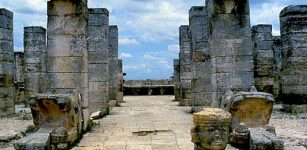Fragments Of Old City’s Fortifications And Carved Hand Imprint Unearthed In Jerusalem
Conny Waters - AncientPages.com - A team of archaeologists from the Israel Antiquities Authority uncovered elements of the city's fortifications and an intriguing carved hand imprint as they dug along Sultan Suleiman Street, between the Damascus Gate and the Lions' Gate.
Image credit: Yuli Schwartz, Israel Antiquities Authority
The excavations were carried out before infrastructure work by the Moriah Development Corporation. The team uncovered part of an ancient defensive moat, believed to date back to the 10th century CE or earlier.
Among the findings was a carved hand imprint that remains a mystery.
Zubair Adawi, Israel Antiquities Authority excavation director, uncovered the moat below the main street. According to Adawi, "The moat, surrounding the entire Old City, dates back about 1,000 years to the 10th century CE or earlier, and its function was to prevent the enemy besieging Jerusalem from approaching the walls and breaking into the city."
The impressive walls and gates of the Old City visible today were built in the sixteenth century by the Turkish Ottoman Sultan Suleiman I, the Magnificent.
Image credit: Yuli Schwartz, Israel Antiquities Authority
"The earlier fortification walls that surrounded the ancient city of Jerusalem were much stronger," says Dr. Amit Re'em, Jerusalem Region Director at the Israel Antiquities Authority.
"Armies trying to capture the city in the Middle Ages had to cross the deep moat, and behind it, two additional thick fortification walls, while the defenders of the city on the walls rained down on them fire and sulfur. As if this wasn't enough, there were secret tunnels in the fortifications, some of them uncovered by the Israel Antiquities Authority archaeologists in previous excavations, whereby the city defenders could emerge into the moat and attack the enemy by surprise, and then disappear back into the city."
During the excavation, a mysterious hand imprint was found carved in the moat wall.
Image credit: Yuli Schwartz, Israel Antiquities Authority
To date, archaeologists have not deciphered the meaning of this carving. "Does it symbolize something? Does it point to a specific nearby element? Or is it just a local prank? Time may tell," say the researchers.
"Many dreamed about and fought for Jerusalem, and the city fortifications are a silent testimony. The archaeological finds enable us to visualize the dramatic events and the upheavals that the city underwent," according to Eli Escuzido, Director of the Israel Antiquities Authority:
"One can imagine the tumult and almost smell the battle smoke. We are daily unraveling the city's intensive military history, and we will make great efforts to exhibit the findings to the public.“
Written by Conny Waters - AncientPages.com Staff Writer























